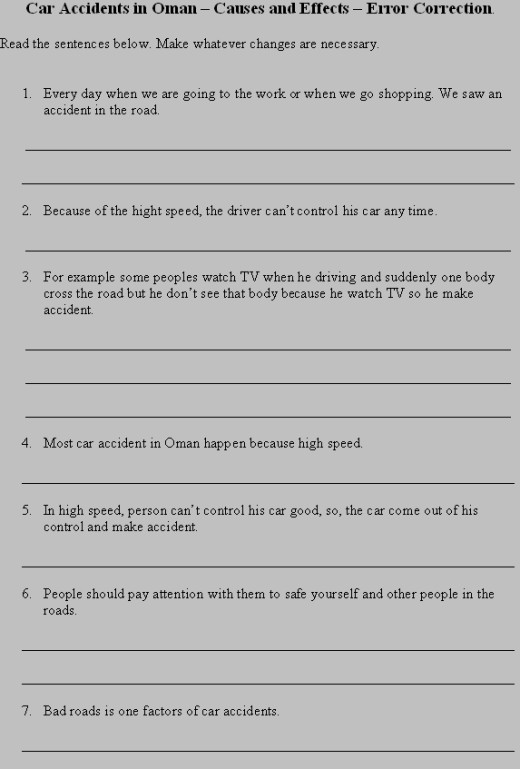Authentic Error Correction
Neil McBeath, Sultanate of Oman
Neil McBeath served as a uniformed Education Officer in the Royal Air Force of Oman from 1981 to 2005. During that time he gained two Masters degrees and the Omani Distinguished Service Medal. Refusing to renew contract in 2005, he taught for two years with BAE Systems in Saudi Arabia. He has now returned to Oman and is teaching at the Sultan Qaboos University. E-mail: neilmcbeath@yahoo.com
Menu
Theory
Practice
Advantages
Disadvantages
References
This activity is based on a fusion of Tomlinson and Masuhara’s work on engagement; Allwright’s (1977) purist view of authenticity in language materials; equally purist approaches to ESP, and Eco’s (2000; 126) observations on “noticing.” It may sound rather daunting, but the activity is easy to create and it works well in the classroom.
- Set an essay title for your class. In this instance, the title was “The Causes and Effects of Car Accidents in Oman.”
Note
One of my colleagues in Oman felt that this was a fairly obvious title, but before being dismissive, we should remember that this is a problem with which the Royal Oman Police have been struggling for years. It is also a topic of which the students are likely, unfortunately, to have personal experience. Indeed, the death toll on the roads of some Arab Gulf states is so high, and so concentrated among young men, that Barlow and Floyd (1998) actually suggest that this is a topic to be avoided, as it may create distress. Rinvolucri (1999), by contrast, would suggest that it is time that the darker side of human experience entered the classroom.
- Mark the first draft of the students’ essays, and select ten, or possibly 12, sentences which contain two or more errors. Make sure you spread the load. Some essays will have no serious errors, others may be riddled with them, but never concentrate on the work of only one or two students.
- Prepare a worksheet with the sentences taken from the essays, and leave room for a corrected version to be written below.
- Complete the worksheet as a class activity. In this instance, pair work or group work run the risk of producing further mistakes, and that could be counterproductive.
- The corrected worksheets can then be used as reference material when the students write their second drafts.
Sample worksheet

Allwright (1977; 8) states that “no materials, published or unpublished, actually conceived or designed as materials for language learning” should be presented to students. His belief is that such materials will inevitably contain inauthentic language. This approach avoids that pitfall. The language is the language of the students, complete with infelicities of expression, poor grammar and spelling errors.
The language also engages the students’ interests because they are the people who produced it. They have an immediate short-term interest in discovering how it can be improved, and in learning how to avoid similar errors in the future – Eco’s “noticing”.
The activity is safely anonymous. Only the original writers know who produced which error.
Because this is quintessential ESP, the materials are designed for use with one class, once. It would be possible, of course, to keep the activity on file, and use it with more than one class, but most of its impact would then be lost. This activity is concerned with the correction of specific errors made by specific students in one specific class; it should not be allowed to degenerate into an attempt to correct decontextualized generic errors.
Allwright, R. (1977). Language Learning through Communicative Practice. In C.J.
Brumfit and K. Johnson (eds) 1977. The Communicative Approach to Language
Learning. Oxford. Oxford University Press. Pp. 2-14.
Barlow, Lisa and Floyd, Jean. (1998) Producing Culturally Sensitive Materials for
Arab Gulf Students. In Salah Troudi; Christine Coombe and Susan Riley (eds) 1998.
Unity through Diversity – Proceedings of the 4th TESOL Arabia Conference.
Al Ain; UAE. TESOL Arabia.
Eco, Umberto (2000) Kant and the Platypus: Essays on Language and Cognition.
London. Vintage Books.
Rinvolucri, Mario. (1999) The UK, EFLese sub-culture and dialect. Folio 2/5 Pp.12-14.

Please check the Methodology and Language for Secondary Teachers course at Pilgrims website.
Please check the Teaching Advanced Students course at Pilgrims website.


|